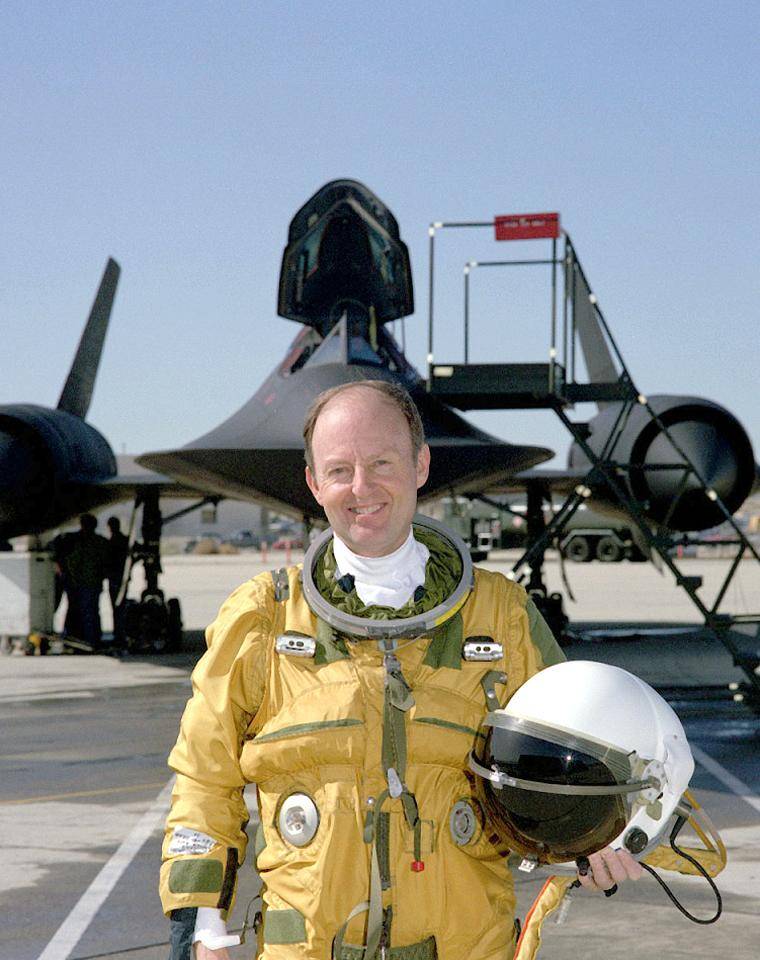EC92-02273
Research pilot Rogers E. Smith is shown here in front of the SR-71 Blackbird he flew for NASA. Rogers was one of the two original NASA research pilots assigned to the SR-71 high speed research program at NASA’s Ames-Dryden Flight Research Facility (later, Dryden Flight Research Center, Edwards, California. Smith has been a NASA research pilot at Dryden since 1982. Data from the SR-71 program will be used to aid designers of future supersonic aircraft and propulsion systems. The SR-71 is capable of flying more than 2200 mph (Mach 3+) and at altitudes of over 80,000 feet.
Three SR-71 aircraft were used at different times during the 1990s by NASA as test beds for high-speed and high-altitude aeronautical research. The aircraft, two SR-71A and an SR-71B pilot trainer aircraft, have been based here at NASA’s Dryden Flight Research Center, Edwards, California. They were transferred to NASA after the U.S. Air Force program was cancelled. .
As research platforms, the aircraft can cruise at Mach 3 for more than one hour. For thermal experiments, this can produce heat soak temperatures of over 600 degrees Fahrenheit (F). This operating environment makes these aircraft excellent platforms to carry out research and experiments in a variety of areas – aerodynamics, propulsion, structures, thermal protection materials, high-speed and high-temperature instrumentation, atmospheric studies, and sonic boom characterization.
The SR-71 was used in a program to study ways of reducing sonic booms or over pressures that are heard on the ground, much like sharp thunderclaps, when an aircraft exceeds the speed of sound. Data from this Sonic Boom Mitigation Study could eventually lead to aircraft designs that would reduce the “peak” overpressures of sonic booms and minimize the startling affect they produce on the ground.
The SR-71 was used in a program to study ways of reducing sonic booms or over pressures that are heard on the ground, much like sharp thunderclaps, when an aircraft exceeds the speed of sound. Data from this Sonic Boom Mitigation Study could eventually lead to aircraft designs that would reduce the “peak” overpressures of sonic booms and minimize the startling affect they produce on the ground.
One of the first major experiments to be flown in the NASA SR-71 program was a laser air data collection system. It used laser light instead of air pressure to produce airspeed and attitude reference data, such as angle of attack and sideslip, which are normally obtained with small tubes and vanes extending into the airstream.
One of Dryden’s SR-71s was used for the Linear Aerospike Rocket Engine, or LASRE Experiment. Another earlier project consisted of a series of flights using the SR-71 as a science camera platform for NASA’s Jet Propulsion Laboratory in Pasadena, California. An upward-looking ultraviolet video camera placed in the SR-71’s nosebay studied a variety of celestial objects in wavelengths that are blocked to ground-based astronomers.
Earlier in its history, Dryden had a decade of past experience at sustained speeds above Mach 3. Two YF-12A aircraft and an SR-71 designated as a YF-12C were flown at the center between December 1969 and November 1979 in a joint NASA/USAF program to learn more about the capabilities and limitations of high-speed, high-altitude flight. The YF-12As were prototypes of a planned interceptor aircraft based on a design that later evolved into the SR-71 reconnaissance aircraft. Dave Lux was the NASA SR-71 project manger for much of the decade of the 1990s, followed by Steve Schmidt.
Developed for the USAF as reconnaissance aircraft more than 30 years ago, SR-71s are still the world’s fastest and highest-flying production aircraft. The aircraft can fly at speeds of more than 2,200 miles per hour (Mach 3+, or more than three times the speed of sound) and at altitudes of over 85,000 feet.1992
NASA Photo
4 min read


























